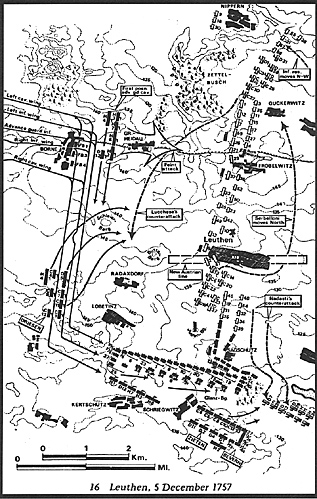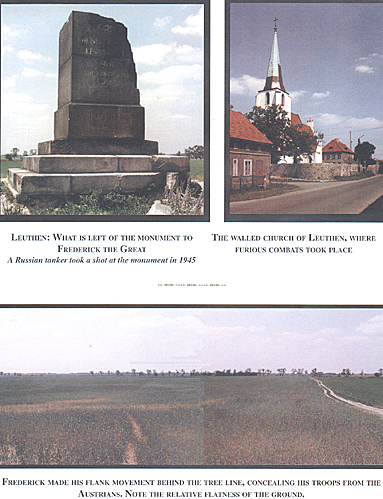 Although Frederick had gained great successes in the
west at Rossbach, he found that his armies had suffered
much in Silesia. His armies had been defeated, some of his
towns and generals captured and when he took command,
he found himself with only some 35,000 mostly dispirited
men to face 80,000 Austrians flushed with success.
Although Frederick had gained great successes in the
west at Rossbach, he found that his armies had suffered
much in Silesia. His armies had been defeated, some of his
towns and generals captured and when he took command,
he found himself with only some 35,000 mostly dispirited
men to face 80,000 Austrians flushed with success.
Battle of Leuthen Jumbo Map (extremely slow: 470K)
One of Frederick's first step was to inform his assembled generals that he intended to attack the stronger Austrians as soon as they were to be found. The regiments were informed of Frederick's decision.
In the 3rd of December, as the Prussian army approached Neumarkt, the Austrians were spotted near Breslau. On the 4th, the Austrian army crossed the Lohe and the Schweidnitzer-Wasser and established itself around Leuthen. Frederick decided to attack the next day.
Frederick's army moved at daybreak from Parchewitz and marched in the following order to Neumarck. The advance guard was composed of 800 volunteers, 10 battalions, 34 squadrons of hussars, 15 squadrons of dragoons and 10 guns. The balance of the army followed in four columns (see plate below and the map of Leuthen) and marched by wings right in front. The first was composed of the two lines of cavalry of the right wing, the second of the lines of infantry of the right wing, the third of the left wing of the infantry, the fourth of the left wing of the cavalry. The artillery followed the two infantry columns.
The Prussian advance guard met and routed an enemy force near the village of Boma. Some 600 prisoners were taken and, to boost the morale of the troops, the captives were led past the Prussian columns. In addition, valuable information as to the exact position of the enemy was obtained from the prisoners. The Austrian right rested on Nipern, protected by a large wood, the Zettel-Busch (the only large wooded area on the battlefield), and some ponds. Their center rested on Leuthen and their left on Sagestchutz. A "crochet" was thrown back to protect this flank, which extended from Sagestchutz to the ponds of Gohlau, the Austrian line of retreat being by Goldschmiede.
The sharp attack made by the Prussians advance guard on the Austrians at Boma and the temporary deployment around 11a.m. of the some elements of the Prussian army as if they intended to march in line directly against the Austrian positions, in addition to their not being able to discover the Prussians' intentions, induced Charles of Lorraine, the Austrian commander, to move his reserve from his left to the right wing.
Frederick knew the ground very well (Leuthen had been the site of Prussian maneuvers). He decided to attack the Austrian left and refuse his own. The ground in front of the Austrian position favored the maneuver. In spite of the fact that the ground in the front of Leuthen was one of the most open and flat in Silesia, the conformation of the Schleier-Berg and the Sophien-Berg offered Frederick the means of executing a flank march southwards, after which a wheel to the east would bring the army into an attacking position perpendicular to Austrian position. In addition, the weather was cloudy. Hence, initially, the Austrians were completely unable to spot the Prussian flank movement.
As soon as the heads of the columns appeared through Boma, they changed direction to the right and filed into two lines.
Later, the move to the south became evident to the Austrian generals who were located in the front of Leuthen. However, they assumed that Frederick must have decided not to attack them on that day. They were to be completely surprised by the Prussian attack on their left flank.
Soon after noon, the sun dispersed the last of the mist as the Prussian columns arrived west of Lobenitz. Frederick directed his columns to the east-southeast.
As soon as Frederick's vanguard passed the village of Kartchutz and Striegwitz on their right, they were ordered to wheel into line and attack. This was done and they captured the village of Sagestchutz. Under the protecting fire of its 10 guns, the main body wheeled into line and advanced against the Austrians. Since the Austrian reserve had been moved to the right, the attack fell on regiments of German auxiliaries mostly from Wurttemberg. For a while, these troops put up a surprisingly strong resistance from a line of willows and then suddenly took to their heels. The rest of the Wurttemburgers to the east routed without ever having come under attack. Then, the Prussian infantry, supported by strong artillery, pushed north unopposed toward Leuthen.
Charles of Lorraine, who now realized how badly he had been tricked by Frederick, tried to reform his line of battle south of Leuthen by stripping some battalions from his second line and wheeling his whole army until it formed a southward facing front through Leuthen and stretching several hundred feet on each side.
At 3:30 p.m., the second phase of the battle started when the Prussian assaulted the new Austrian line of defense. The repeated Prussians attacks were repulsed until a breakthrough opened a way into Leuthen. Leuthen was finally carried after furious combats took place especially around the church.
The Austrians continued their resistance after Leuthen had been taken by the Prussians and the combat degenerated in a standing firefight as the Prussian advance came to a halt.
The final decision came around 5pm when the Austrians launched an attack with 70 squadrons on the left flank of the Prussian infantry. That dangerous attack was countered by the commander of the left wing Prussian cavalry, Lieutenant-General von Driesen. The Austrians were in turn taken in flank by some 35 squadrons of cuirassiers and, then, 30 more squadrons from the Prussian reserve joined the fray. The mass of struggling cavalry bore down on the Austrian infantry which finally broke down and fled.
Frederick with 48 battalions (21,000), 129 squadrons
(11,000), 167 guns, totaling 33,000 suffered 11,589 casualties
and decisively defeated 65,000 Austrians (85 battalions, 125
squadrons and 210 guns) and inflicted 22,000 casualties
including 12,000 prisoners and captured 131 guns. [3]
The battle of Leuthen is an epoch in the annals of
military art and is considered as the perfect example of the
oblique order which had worked to near perfection. Leuthen
contained not only the theory but also the practice of the
system of which Frederick was the author. Leuthen was
considered as the greatest victory of that generation. [4] .
The Leuthen battlefield is in Silesia, which is now part
of Poland. Silesia became a Polish province in 999 when it
was conquered from Bohemia by Boleslav the Brave. Then,
it was lost to the Austrian Empire which in turn lost Silesia
to Prussia in 1742. Silesia remained part of Prussia and then
Germany until 1945 when Silesia once more became part of
Poland. At that time, the German population was moved out
of Silesia. All the German names of the cities, villages and
towns reverted to their original Polish names which have
often very little in common with their former German names.
If you visit these battlefields, we recommend that you have
a Polish speaking person with you because your English
won't do you any good in the small villages of Silesia. In
addition, a
comprehensive translation of the German names into Polish
names is mandatory. (We were lucky to find someone
speaking French in the city of Breslau and German in
Leuthen, but don't push your luck.) Aside from that, the
Leuthen battlefield has changed very little since the Seven
Years War. It is still part of an essentially agricultural
province. The Leuthen battlefield is very flat as shown in
the photos.
Frederick's "Oblique Order"
 The Battlefield Today
The Battlefield Today
Introduction
Prussian Tactics 1757 and the Oblique Order
Battle of Prague: May 6, 1757
Battle of Leuthen: December 5, 1757
Battle of Kolin: June 14, 1757
Conclusions, Notes, and Bibliography
Back to Empire, Eagles, & Lions Table of Contents Vol. 2 No. 4
Back to EEL List of Issues
Back to MagWeb Master Magazine List
© Copyright 1994 by Emperor's Headquarters
This article appears in MagWeb (Magazine Web) on the Internet World Wide Web.
Other articles from military history and related magazines are available at http://www.magweb.com
